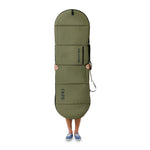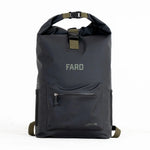
Protecting your surfboard isn't just smart—it's essential. Whether you're a weekend warrior or a daily ripper, your board takes a beating outside the water just as much as in it. The good news? There are two reliable ways to shield your surfboard from damage: surfboard socks and surfboard bags.
But which option is better for your needs? Is it worth spending more for a rugged bag, or will a lightweight sock do the trick? In this guide, we’ll help you decide by breaking down everything you need to know—from materials and fit to cost, function, and daily use.
Let’s dive into the details so you can choose the best surfboard protector for your quiver.
What’s the Difference Between a Surfboard Sock and a Surfboard Bag?
At a glance, both surfboard socks and surfboard bags serve the same purpose: to protect your board. But the level and type of protection they offer varies dramatically.
While surfboard socks offer lightweight, daily-use protection mostly for short trips or storing at home, surfboard bags are padded, travel-ready, and more versatile overall. Let’s compare both options in more detail below.
Surfboard Bags – Maximum Protection, Travel Ready
Surfboard bags are the go-to option if you're serious about keeping your board in pristine condition. Designed to absorb impact and guard against UV rays, heat, and moisture, they’re ideal for both daily use and long-haul trips.
Materials and Durability
Most surfboard bags on the market are built from heavy-duty materials like tarpaulin or poly canvas, with padded interiors and zipper closures. However, FARO surfboard bags are made from 600D recycled polyester canvas, offering both superior durability and sustainability.
Some bags include roll-buckle closures instead of zippers to avoid corrosion and breakage. For zippered models, look for non-corrosive YKK #10 plastic zippers, which FARO uses in its bags, ensuring long-lasting use even in salty, wet environments.
FARO’s board bags are also waterproof and heat-resistant, preventing issues like wax melting or mold buildup—common problems in cheaper alternatives.

Size and Fit
Surfboard bags are typically true to size, but it’s important to check manufacturer specifications. For example, a 9'0" bag may not fit a 9'2" noserider unless the bag has added room or adjustability.
FARO adjustable bags make sizing simpler, with flexible fits ranging from 6’ to over 10’, plus roll closures that give up to three extra inches of storage. For travel, this extra space can be a lifesaver.
Want to keep your fins on? Most FARO longboard bags come with built-in fin slits, and shortboard models have enough flexibility to accommodate attached fins—especially with the roll closure design.
Daily Use and Travel
Surfboard bags shine when it comes to daily commuting, road trips, and international surf travel. The padding protects your board against baggage handlers, bumpy roads, and overpacked cars. They also keep UV rays at bay, which helps prevent yellowing and resin breakdown.
Bonus: you can toss your wet wetsuit in a FARO bag too—the waterproof lining keeps your gear separated and your car dry.
Cost and Value
High-quality surfboard bags typically range between $100–$250 depending on brand, size, and features. While they cost more than socks, the protection and longevity they offer make them a smart investment, especially for surfers with multiple boards.
Many FARO canvas bags are adjustable to fit multiple board sizes, so you may only need one bag for your entire quiver—maximizing value.
Surfboard Socks – Lightweight and Budget-Friendly
Surfboard socks are minimalistic board covers designed for casual, short-distance use. They're ideal for surfers who walk or bike to their local break or for protecting boards stored at home.
Materials and Build
Most board socks are made from a cotton-knit stretchable fabric, with light padding near the nose for added safety. FARO socks are crafted from breathable, UV-resistant material—but note that most socks are not waterproof or quick-drying.
Cotton-blend socks tend to absorb moisture and retain odors, so drying them thoroughly after each use is necessary. Frequent washing is also recommended to prevent mold or mildew buildup.
Unlike bags, board socks come with simple drawstring closures, which rarely break. However, socks offer minimal impact protection and should not be used for flights or international trips.

Fit and Flexibility
Surfboard socks are built to stretch, often covering boards within a +/- 3” range. An 8' sock can typically cover boards from about 7’6” to 8’3”.
However, the more you stretch it, the more tension you place on the material—leading to potential rips and faster wear. If you're carrying a finned board, the stretch may prevent full closure or cause damage over time.
FARO canvas bags offer similar flexibility but with much more durability and weather resistance.
Leash and Wetsuit Compatibility
Socks can hold your board with fins, but if you're pushing the size limits, removing the fin may be necessary. As for leashes and wetsuits, the absorbent material isn't ideal. A wet leash will stick to the cotton, and a soaked wetsuit can turn your sock into a soggy mess.
Again, socks are better suited for quick trips and light protection, not as an all-in-one storage solution.
Price and Value
Surfboard socks generally cost between $40–$70. They're a good budget option for daily surf sessions close to home. However, for frequent surfers or those traveling with boards, socks may wear out quickly or fail to provide sufficient protection.
Surfboard Sock Alternative?
If you need a surfboard bag that is less bulky than a padded day bag but want a little more versatility than you standard surfboard sock try FARO Canvas Surfboard Bags, which are the perfect crossover between standard surf padded bags and board socks.
Surfboard Bag vs. Sock – Which One Should You Choose?
Choosing between a surfboard sock and a bag depends entirely on your surfing lifestyle, travel needs, and budget.
Go with a Surfboard Bag if:
-
You travel frequently or take surf trips by car or plane
-
You need a bag to store wetsuits, leashes, or accessories
-
You want extra padding and UV/moisture protection
-
You’re protecting multiple boards with one adjustable bag
-
You want a long-lasting investment in board protection
FARO’s Adjustable Surfboard Bags are built for exactly this. Explore our full range here.

Choose a Surfboard Sock if:
-
You only surf locally and walk or bike to your break
-
You want a lightweight, breathable cover for sun protection
-
You’re on a tight budget and don’t need heavy-duty padding
-
You’re okay with limited storage and less durability
Looking for a quick solution for sun and scratch protection? Browse our FARO board socks.
Still Not Sure What to Get? Let Us Help
If you’re unsure which option fits your needs, reach out to our team—we’re happy to recommend the right surfboard protection for your quiver. You can also check out our guide: How to Travel with Your Surfboard Safely.
Final Thoughts
In the end, surfboard socks and bags both have a place in your gear lineup. For lightweight daily use, socks get the job done. But for full-scale protection, especially during travel, a well-designed bag—like the ones we make at FARO—is a no-brainer.
Protect Your Board — Shop Surf Bags & Socks Now
Protect your quiver. Extend your board’s life. Surf more, stress less.
FAQs





